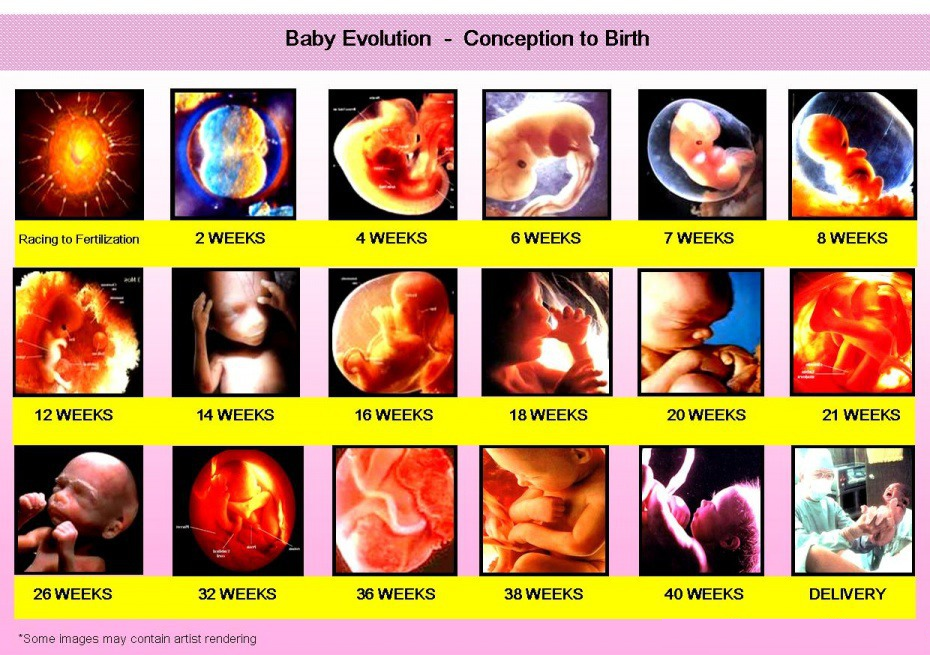How Babies Grow
All embriology (the study of the embryo) medical textbooks tell us that life begins at the moment of conception when the man's sperm meets the woman's egg.
The images and videos featured of this page show what is happening inside the mother's womb as the baby develops from the moment of conception to birth.
Here are some key milestones of the baby's development:
Early Days
Day 1: fertilization: all human chromosomes are present; unique human life begins.
Day 6: embryo begins implantation in the uterus.
Day 22: heart begins to beat with the child's own blood, often a different type than the mothers'.
First Trimester
Week 3: By the end of third week the child's backbone spinal column and nervous system are forming. The liver, kidneys and intestines begin to take shape.
Week 4: By the end of week four the child is ten thousand times larger than the fertilized egg.
Week 5: Eyes, legs, and hands begin to develop.
Week 6: Brain waves are detectable; mouth and lips are present; fingernails are forming.
Week 7: Eyelids, and toes form, nose distinct. The baby is kicking and swimming.
Week 8: Every organ is in place, bones begin to replace cartilage, and fingerprints begin to form. By the 8th week the baby can begin to hear.
Weeks 9 and 10: Teeth begin to form, fingernails develop. The baby can turn his head, and frown. The baby can hiccup.
Weeks 10 and 11: The baby can "breathe" amniotic fluid and urinate. Week 11 the baby can grasp objects placed in its hand; all organ systems are functioning. The baby has a skeletal structure, nerves, and circulation.
Week 12: The baby has all of the parts necessary to experience pain, including nerves, spinal cord, and thalamus. Vocal cords are complete. The baby can suck its thumb.
Week 14: At this age, the heart pumps several quarts of blood through the body every day.
Week 15: The baby has an adult's taste buds.
Second Trimester
Month 4: Bone Marrow is now beginning to form. The heart is pumping 25 quarts of blood a day. By the end of month 4 the baby will be 8-10 inches in length and will weigh up to half a pound.
Week 17: The baby can have dream (REM) sleep.
Week 19: Babies can routinely be saved at 21 to 22 weeks after fertilization, and sometimes they can be saved even younger.
Week 20: The earliest stage at which Partial birth abortions are performed. At 20 weeks the baby recognizes its' mothers voice.
Months 5 and 6: The baby practices breathing by inhaling amniotic fluid into its developing lungs. The baby will grasp at the umbilical cord when it feels it. Most mothers feel an increase in movement, kicking, and hiccups from the baby. Oil and sweat glands are now functioning. The baby is now twelve inches long or more, and weighs up to one and a half pounds.
Third Trimester
Months 7 through 9: Eye and teeth are present. The baby opens and closes his eyes. The baby is using four of the five senses (vision, hearing, taste, and touch.) He knows the difference between waking and sleeping, and can relate to the moods of the mother. The baby's skin begins to thicken, and a layer of fat is produced and stored beneath the skin. Antibodies are built up, and the baby's heart begins to pump 300 gallons of blood per day. Approximately one week before the birth the baby stops growing, and "drops" usually head down into the pelvic cavity.
Sources
- Bergel, Gary. "When You Were Formed in Secret." (an INTERCESSORS For AMERICA publication). 9th ed. 1998.
- Flanagan, Geraldine Lux. BEGINNING LIFE. The Marvelous Journey from Conception to Birth. New York: DK Publishing Inc., 1996.
- Hopson, Janet L. Fetal Psychology. Oct. 1998. 07 Jan 2003. www.psychologytoday.com/us/articles/199809/fetal-psychology
- Westside Pregnancy Resource Center. "Fetal Development." (Santa Monica, CA).07 Jan 2003. w-cpc.org/fetal1.html.*archived webpage
- "When does life begin? Abortion and Human Rights." www.nrlc.org/abortion/wdlb/



